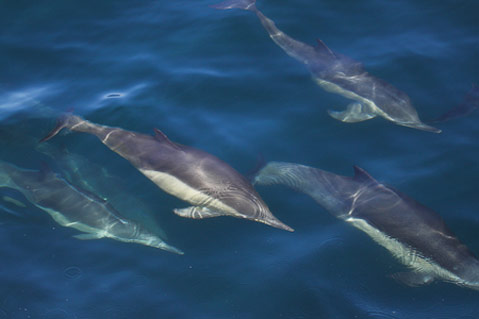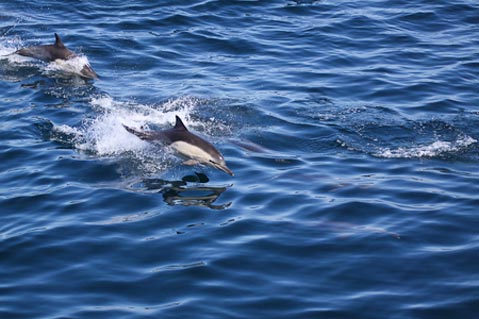Whale Watching on the Condor
Humpbacks Come to the Channel Early This Year

You may not hear the humpback’s song-unless you go underwater-but you can witness the grand creatures when they surface, each spring, in the Santa Barbara Channel. The humpbacks usually arrive in our nutrient-rich ‘hood in May, resting and refueling before continuing south to warmer waters. This year, they came about a month earlier than expected, so I hopped onto the Condor Express one bright morning in April for a two-and-a-half-hour tour.

It was a beautiful day, with glassy seas and blue skies. Several dozen second-graders from Foothill Elementary school were also aboard the whale-watching boat. I bought an apple-cinnamon muffin and a mocha (which I would later regret) from the Condor‘s snack bar and went topside for whale spotting. Less than half an hour later, we were well into the Channel and a pod of black-and-white Dall’s porpoises were racing the bow of the boat, showing off their agility and grace.

The swells were large; the Condor rose and dropped like a rollercoaster. The boat trolled the area where humpbacks had last been seen, but found no spouts or flukes. What we did see were tons of the aforementioned Dall’s porpoises, as well as common dolphins, sea lions, and harbor seals too, all munching anchovies and the like. It was a spectacular feeling to be out among them.

The captain slowed the boat to a crawl. As we waited for the humpbacks, seasickness swept over passengers and soon schoolchildren-and a few adults-were running for the head or heaving over the side of the boat. Although I kept my breakfast down, I did turn several shades of green. (Tip: Don’t be fooled by smooth-looking waters: Once you’re in the Channel, anything goes, so if you’re prone to motion sickness, take appropriate medicinal measures before starting out.)

While we waited, an onboard volunteer naturalist explained that humpbacks are a species of baleen whale, feeding mostly on krill and small fish, and each one has a distinctive tail fluke. This has allowed researchers to follow and observe individuals’ behaviors without the aid of tagging or homing devices. Finally, our patience paid off: spout spray to starboard. The Condor motored closer to join no less than three humpbacks as they dived and rolled, displaying as they did so their famous curving profiles.
We didn’t see any Pacific gray whales that day, but they’re out there, and are “scheduled” to be cruising through the Channel toward Alaska through the end of April with their newborns. Orcas and finback whales are expected in early May, as is Earth’s largest mammal, the blue whale. To see the blues you must go all the way out to the Channel Islands, a half-day trip. Longer trips farther offshore may also give you a glimpse of sperm whales and beaked whales. It’s a jungle out there!
4•1•1
Call the Condor at 882-0088 for trip reservations or go online to condorcruises.com



